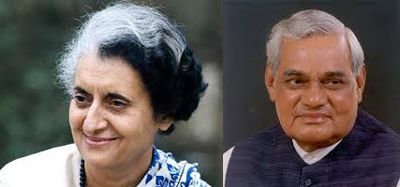Emerging Political Trends 1977 to 2000
Sakshi Education
 Key points:
Key points: - The period between 1975 and 1985 was a testing time for Indian democracy.
- The election of 1977 was a historic election for Indian democracy. The Janata Party had come to power promising a restoration of democracy and freedom from authoritarian rule.
- N.T. Rama Rao, a popular film actor, started Telugu Desam Party (TDP) in 1982. He declared that TDP would stand for the honour and self-respect of the Telugu people.
- In Assam, the locals felt that they would their cultural roots were being destroyed due to incoming of large number of illegal immigrants from Bangladesh. The All Assam Students’ Union (ASSU) led a strong agitation against the central government with the main demand to stop the illegal immigration of outsiders.
- In Punjab, an agitation came into being with the demand to separate Punjab from India and another country with the name ‘Khalistan’ shall be formed. The Khalistan movement forced the central government to take stern actions such as merciless police operations. Mrs. Indira Gandhi who initially encouraged these separatist elements for her political gains ordered for ‘Operation Blue Star’, in which a lot of militants and their ring leader Bhindranwale killed. .
- Rajiv Gandhi initiated the Telecom revolution in India which speeded up and spread the telecommunication network in the country.
- In 1989, the first coalition government led by V.P. Singh of Janata Dal was formed.
- Operation Barga and strengthening of Panchayati Raj systems helped the Communist Party of India (Marxist) (CPI (M)) to continue in power till 2006.
- Mandal Commission provided for backward class reservations in employment and educational opportunities.
- P.V. Narashimha Rao’s government introduced Liberalisation, Globalisation and Privatisation in 1991.
- Regional Aspirations: Strong desires of people from particular region. Feelings of the people of a state or region in support of their culture, language or region which are translated into social or political movements.
- Coalition Government: Government headed by a group of parties in known as coalition government. Generally coalitions form when no party has absolute majority and largest party leader becomes head of the government such as Chief Minister, Prime Minister or President and the allies get ministerial positions.
- Communalism: A strong sense of religious belonging which lead to extreme behavior or violence against other religions.
- Majority: A party securing highest number of seats in an electoral, the number that is sufficient to control a house. Majority can be secured by alliance of more than one parties, which is known as coalition.
- Minority: A party having number of seats that are sufficient to get to public office, but next to the majority party/group is considered as minority government.
- How did regional aspirations lead to the formation of regional parties? Compare the similarities and differences between the different phases?
i. In Andhra Pradesh, the change of CMs by the Congress high command and imposition of leaders from New Delhi created a feeling that the state leadership and Telugu people respected by the Congress leadership. This was seen as an insult to the pride of Telugu people.
ii. N.T. Rama Rao, a popular film actor, began the TDP in 1982 with the supposed objective of defending the honour and self respect of the Telugu people.
iii. Similarly in Assam, infiltration of large number of illegal immigrants from Bangladesh rendered local Assamese jobless. This provoked the Assamese to agitate against the situation. The student organisation All Assam Students’ Union (ASSU) conducted agitations against the outsiders. Gradually this agitation was spread throughout Assam. A party grown out of AASU – the Assam Gana Parishad (AGP) won a comfortable majority in Assam Assembly.
iv. During the 70s and 80s, people of many states felt alienated and wanted either greater autonomy from the centre or even wanted to go separate from India itself.
v. Khalistan movement’s violent activities in Punjab, which were initially supported by Mrs. Indira Gandhi, later forced to take up a military attack called ‘Operation Blue Star’. The TDP of Andhra Pradesh and AGP of Assam are the best examples of regional parties which were formed due to the raise of regional aspirations.
- In order to form governments it became necessary for political parties to attract people from different sections of society. How different political parties appealed to cross section of people in the second phase after independence?
i. The Janata Party promised the restoration of democracy and freedom from authoritarian rule and this had helped the party to make huge gains in 1977 elections.
ii. TDP stated it will defend the honour and self-respect of Telugu people, which have been robbed away the Congress government in New Delhi.
Mr. N.T. Rama Rao alleged that state was being treated as a lower office of the Congress party. He promised various welfare measures for the poor including -
a) Midday meal scheme in government schools
b) Sale of rice at Rs 2/- per kg to the poor
c) Liquor prohibition.
iii. The protest against Hindi by DMK in Tamil Nadu was partly political and partly due to the pride that Tamilians hold about their mother tongue.
iv. The protest of Assam people was due to influx of large number of Bangladeshi immigrants into Assam. One of the negative results of the influx was heavy competition for the job opportunities. Trade and other establishments have gone into the hands of non-Assamese communities. Under these conditions Assam Gana Parishad came to power.
v. Some political parties fight for reservations to particular castes and communities. Assurance of employment is also an attractive issue to be taken up by political parties.
- What were the developments that weakened the inclusive nature of Indian polity? How is the ability to accommodate different communities and regional aspirations changing?
i. The Janata Party had come to power promising restoration of democracy and freedom from authoritarian rule.
ii. However, the actions of both the Janata and Congress governments weakened the federal principles and supported centralisation of power in New Delhi. Their attitude had created some serious challenges to unity of the country.
iii. In Andhra Pradesh, frequent change of CMs by the Congress leadership sent wrong signals to Telugu people, whose self-respect was deeply hurt. N.T. Rama Rao, a popular Telugu actor chose to raise the issue and had established TDP in 1982.
iv. Apart from this, the majority party government does not allow the state government ruled by the opposition parties to continue in power.
v. States felt alienated and demanded reduction of centre’s interference in the state matters.
- In the first 50 years after India’s independence, importance was given to planned development. From the start of second half-century, the emphasis shifted to liberalisation. Discuss and find out how does reflect a political ideals?
i. In the first 50 years after independence, importance given to planned development to develop the agriculture and basic infrastructure.
ii. In 1991, when the V.P. Singh’s government collapsed, India was facing a very serious economic crisis. The country’s foreign currency reserves, with which it repays its loans and pays for imports, were on the brink of exhaustion. This could have lead to country’s default in payments to foreign countries unless it urgently got some loan.
iii. In 1992, the new Congress government under P.V. Narshimha Rao was formed. The government immediately negotiated with the International Monetary Fund (IMF) for loans to tide over the crises. The IMF laid down certain stringent conditions, which forced India to accept a policy of liberalisation.
iv. The 20th century closed with an India which was drawn in to world market, an India which seemed to have a thriving democracy in which voices of different sections of the population were making themselves heard and in which divisive and communal political mobilisation was threatening to destroy social peace.
v. It still had not managed to solve the problems of acute poverty and gross in equality between castes, communities, regions and gender.
All the economic policies of the parties and our governments were the reflection of the political ideals.
- Read newspapers and magazines to identify at least one example each of moderation in policies due to coalition compulsions; and how different political parties in coalitions emphasize their regional demands?
i. The regional parties like DMK and TDP demanded the development in railways in their states. They wanted many new trains and new railway zones to their states. Trinamool Congress (TMC) demanded modernization in West Bengal during Congress coalition.
ii. The policy of liberalisation forced Indian business to compete with global manufacturers, which was a best thing to happen. The policy shift also led to the setting up of new industries and business by foreign companies in India.
iii. During initial days of this shift, common people faced a lot of hardship as the government was forced to cut subsidies and thousands of factories closed down due to influx of cheap foreign goods. This policy also lead to privatisation of important public amenities such as education, health and transport services and people had to pay high price to get services from the private service providers.
iv. During the UPA-I and UPA-II that were being headed by Dr. Manmohan Singh, many allies demanded not open up retail space to multinational companies citing the fears that they would become a threat to small trades. Thus, the coalition governments had to face the demands of their regional allies.
- Match the following
1. Economic Liberalisation [A ] (a) Restriction on foreign import Tax
2. Arbitrary dismissal [B] (b) of state governments by central Govt.
3. Ethnic cleansing [C] (c) mass killings of people who are different sect, tribe or a religion
4. Federal principle [D] (d) greater autonomy for state Governments.
- Identify the major changes in party system during the second quarter after independence?
i. During the second quarter after independence, Indian parties and the party system have undergone remarkable changes. The single party dominance became past and era of coalition governments started.
ii. The pluralistic nature of India’s federal polity began to assert itself in the political domain. During this phase, we have seen national parties became dependent on regional and small parties.
iii. Commencement of coalition era was the major development during the second quarter after independence.
- What are the major economic policies of various governments at the center and the state level discussed in this and previous chapters? How they are similar or different?
i. Rajiv Gandhi moved towards a more liberalised system in the economic sphere by removing some of the checks and controls that were in place.
ii. He believed that India needed to adapt itself to the new technologies emerging in the world, especially “the Computer and Telecommunication Technologies”. He initiated the spread of telecommunication network in the country by improving satellite technology.
iii. In 1992, the new Government formed under the leadership of P.V. Narashimha Rao negotiated with the IMF for loans to tide over the crises. The IMF forced India to accept the pill of liberalisation. This was opposed by many parties as they felt that this would crush our manufacturers and small traders and encourage the foreign companies. This policy eventually allowed privatisation of many public amenities.
iv. In June 1978, the West Bengal government leaf by Left Front launched Operation Barga to record the names of sharecroppers and to secure their rights. As a result, the bargadars secured their pre-eminent rights over the land. The state guaranteed that the bargadars would receive a fair share of the crop. As a result, the rural poverty declined in West Bangle.
v. In Andhra Pradesh, the TDP government introduced various welfare measures for the poor.
Thus, the economic policies implemented at the state and central were different at the centre and the state level.
- How different types of regional aspirations were drawn from cultural and economic dimensions?
The protest of Assam people against absorption of outsiders into the state was with the demand to preserve their culture. The protest against Hindi by DMK in Tamil Nadu and the protest of NTR to the domination of central government were the symbols of cultural protests. Jai Andhra movement, which took place in 1972, was a protest against lack of economic opportunities to erstwhile coastal Andhra districts.
Published date : 24 Dec 2014 11:01AM


















